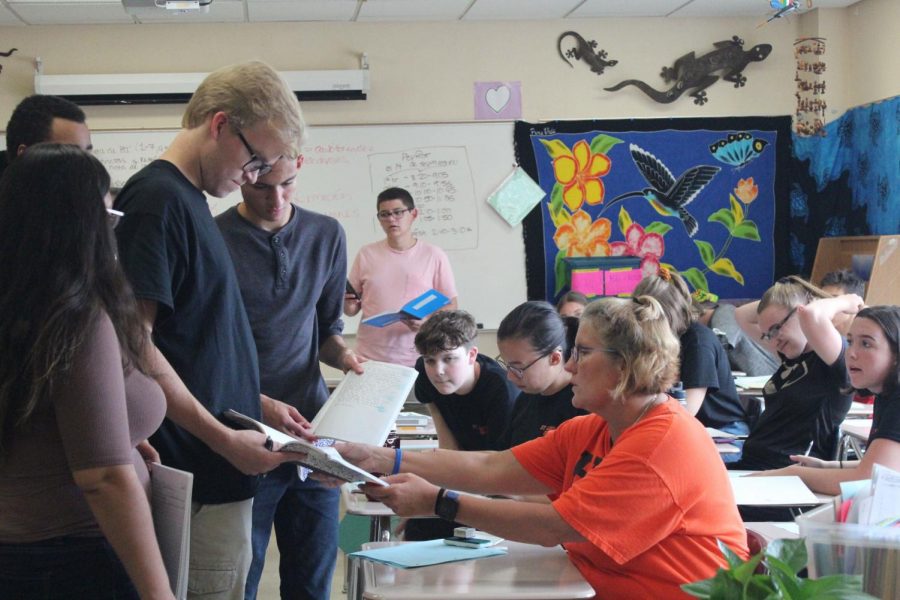Class numbers push limits
IB Spanish class exceeds 40 students
IB Spanish teacher Jane Hudacek checks senior Casey Kreie’s homework during her sixth hour class Sept. 26. During this period she teaches 41 students.
October 11, 2018
With the high demand to practice language in high school, senior and IB Spanish student David Gutierrez said he was surprised to see that on the first day of school not everyone in class had a desk.
“On the first day I was definitely a little shocked when I saw how big the class was, and every student should have a desk,” Gutierrez said.
IB Spanish teacher Jane Hudacek said the number of students in the program is not the problem, but the physical size of the class is.
“The situation is that there (are) a lot of students in my IB Spanish, which is a good thing, but there is only one section which means that there are a lot of kids in one class,” Hudacek said. “Right now we are three desks short.”
Principal Scott Meyers said that having one big class as opposed to two small classes statistically becomes the best option like cases of IB Spanish.
“We like to keep class sizes at around 30 in the spring to make sure it’s safe so it doesn’t get too small,” Meyers said. “When we get into the fall we are stuck in a predicament where we run a class at 32 and kids start to add and then it gets up to 35 plus, but when you split that mathematically, you get two small classes and also its a factor of can you balance them, and splitting a class perfectly in half can’t always happen.”
Hudacek said that personal connections in language are very important, and when her class is twice the ideal size it causes problems.
“When there are a lot of students, the longer it takes for students to get focused,” Hudacek said. “In a language class, the challenge is the one on one attention students need and also the attention in pairing and partnering and things like that, so the ideal world language, especially for IB, would be around 24 or 25, and right now there 41.”
Gutierrez said the class size doesn’t really bother him, but he would like a smaller class to improve his learning experience.
“Personally, I wouldn’t mind either a smaller or big class, but I don’t want to stay on the fence so I’d say I would rather have a smaller class because it can be more intimate,” Gutierrez said.
Hudacek said students will need to be more self-directed than normal due to the large class size.
“There’s going to be some ownership on the students’ part to be self-directed and focused. The problem normally speaking in classes where there are a lot of students, is that it’s difficult for students to express their opinion and ask questions when there are so many bodies in the room,” Hudacek said.
Meyers said IB language is a fluctuating class size through the years and can go from two small 20 person classes to one big 40 person class, based on scheduling.
“The really tricky part is that big class sizes are a good sign of growth or interest, so we see it sometimes in French or Spanish where there might be a higher interest but sometimes in a transition year a class ends up big but likewise IB language will end in 15 or 20 which people might want to take but leaves a small class,” Meyers said.
Hudacek said her ideal solution to the issue would be creating two classes, but with scheduling issues, it is not always possible.
“I would like another class, but the issue seems that even though ideally two classes for IB Spanish would be good, not all the kids in IB Spanish test IB, whether they are not an upperclassman or they opt out,” Hudacek said.
Hudacek said that even with the troubles of a large class, she will always encourage people to be a part of a language in high school for all the benefits it can have later in life.
“More students is great, but that isn’t the problem. We want everyone who wants to take IB Spanish to take it and to continue with their language growth and skill,” Hudacek said.




